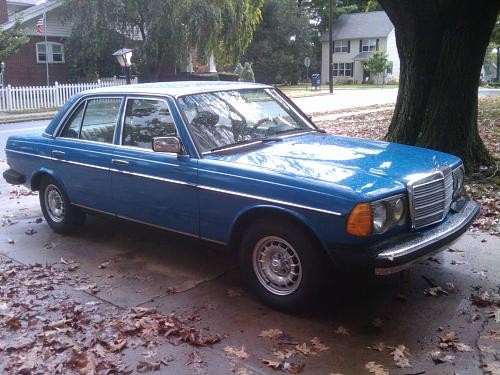For enthusiasts seeking a blend of classic charm and everyday usability without breaking the bank, the Mercedes-Benz W123 series, particularly the 300D model, stands out as an exceptional choice. Produced from 1977 to 1985 for the US market, the W123 embodies Mercedes-Benz’s historical commitment to “The Best or Nothing,” a philosophy they are striving to recapture today. Imagine being able to purchase a brand-new W123 300D in today’s market – it would be a vehicle offering a unique combination of road feel, responsive handling, unparalleled comfort, impressive durability, and steadfast reliability, all within a practical size. While a new W123 remains a dream, the allure of well-maintained vintage models is undeniable. Consider this intriguing blue 300DT, currently listed on Benzworld at an appealing price of just $3200.
The Mercedes-Benz W123 300D, especially the diesel variants, are renowned for their remarkable longevity, often clocking hundreds of thousands of miles. However, their robust nature sometimes leads to neglect. While some owners prioritize mechanical upkeep to ensure these vehicles keep running, the interior and exterior aesthetics may be overlooked. Despite this potential for wear and tear, the inherent quality of materials used in W123 construction means that even cars showing signs of age can be revitalized to a high standard with reasonable effort. A significant advantage for W123 owners is the readily available supply of both new and used parts. Mercedes-Benz still offers a range of new components, and a thriving network of Mercedes wrecking yards across the country ensures that finding replacement parts, whether interior trim or exterior panels, is generally straightforward.
Prospective buyers of a Mercedes-Benz 300D should be aware of common trouble areas. Rust is paramount concern for W123s, particularly in regions with harsh winter conditions and road salt. These vehicles, while well-engineered, were not originally designed with the advanced rust protection methods of modern cars. Key areas prone to rust include the front valance, rocker panels (especially around jacking points), lower sections of fenders and doors, areas behind beltline moldings, the lower rear quarter panels, and the rear door opening “doglegs.” A thorough inspection of the entire body is crucial. Inside the cabin, water leaks are a frequent issue, often stemming from degraded front or rear window seals or blocked drainage channels. Signs of water intrusion include dampness in the rear footwells, indicated by soggy carpets, and a persistent musty odor that can be difficult to eliminate. Cracked dashboards are also common, particularly in vehicles with blue interiors. While dash caps offer a cosmetic fix that approximates the original appearance, they are not a true substitute for an undamaged original dashboard.
This particular blue Mercedes Benz 300d is compelling because the seller indicates that rust issues have been addressed, a significant plus point, although the quality of the repair work would require careful evaluation. The interior is described as being in remarkably clean condition, especially considering it features the parchment-colored MB-tex upholstery, which in many similar cars often exhibits wear consistent with heavy use. The turbodiesel engine in the 300D is arguably the most desirable powertrain option for the W123. While it may not match the outright power and acceleration of the M110 2.8 DOHC inline-6 gasoline engine, the diesel offers superior fuel economy and operates under less stress, contributing to enhanced long-term durability. Despite being a diesel, the 300D’s performance is respectable, achieving 0-60 mph times in the 11-13 second range depending on testing variations, reaching a top speed around 100 mph, and comfortably cruising at 80 mph for extended periods.
If considering purchasing this Mercedes Benz 300D, a worthwhile upgrade would be replacing the standard US-spec sealed-beam headlights with the rectangular European headlights that were originally designed for the W123. While headlight preference can be subjective, European headlights offer significantly improved visibility and safety. Aftermarket European headlight units, including bulbs and turn signals, are available for a reasonable price, typically under $300. The seller notes that “almost” everything on this 300D functions correctly, with the exception of the tachometer, a fairly common issue often linked to the tachometer amplifier. A crucial question not explicitly addressed in the listing is the operational status of the automatic climate control system, which can be complex and costly to repair if faulty. The asking price for this Mercedes Benz 300D appears to be in line with market values for a clean 300DT with approximately 260,000 miles, assuming there are no major undisclosed issues. For someone looking for a distinctive classic car for regular use, offering a blend of vintage appeal and modern driving comfort, the W123 300D is hard to surpass. Alternatively, the seller also has a 1986 300E with orthopedic seats available, catering to those who prefer a gasoline-powered option.
